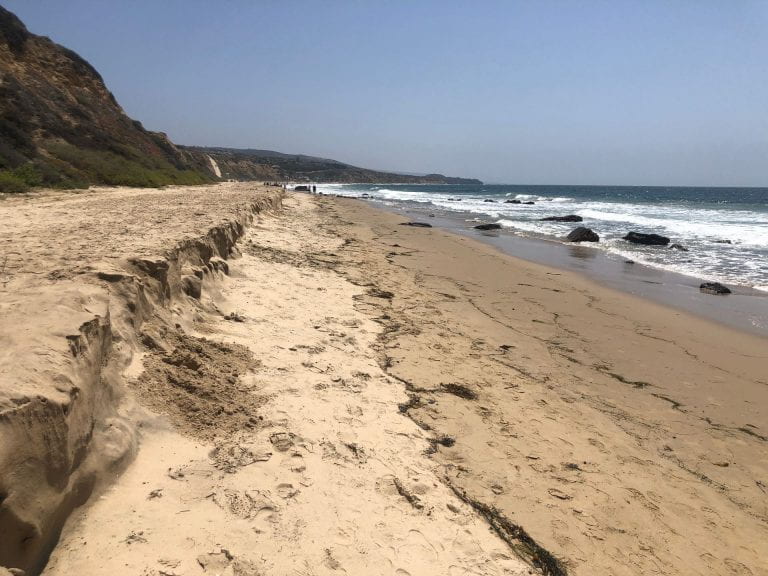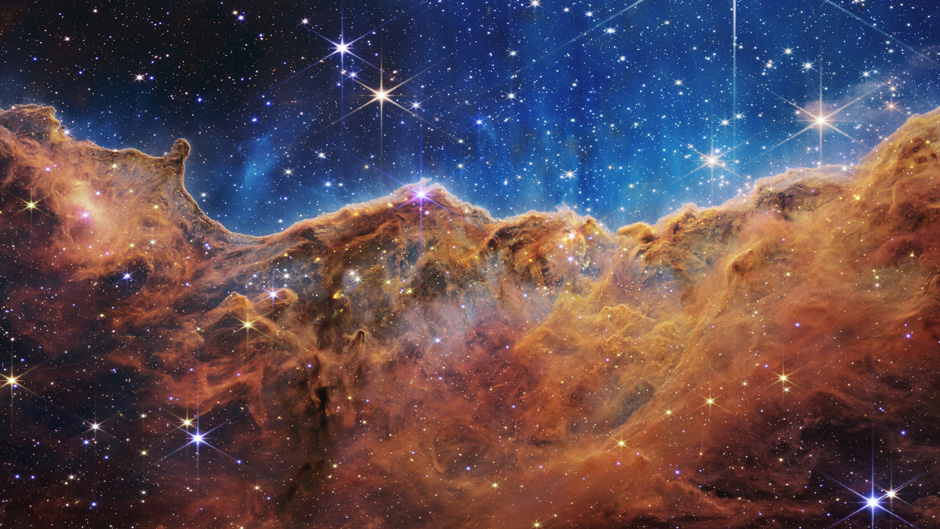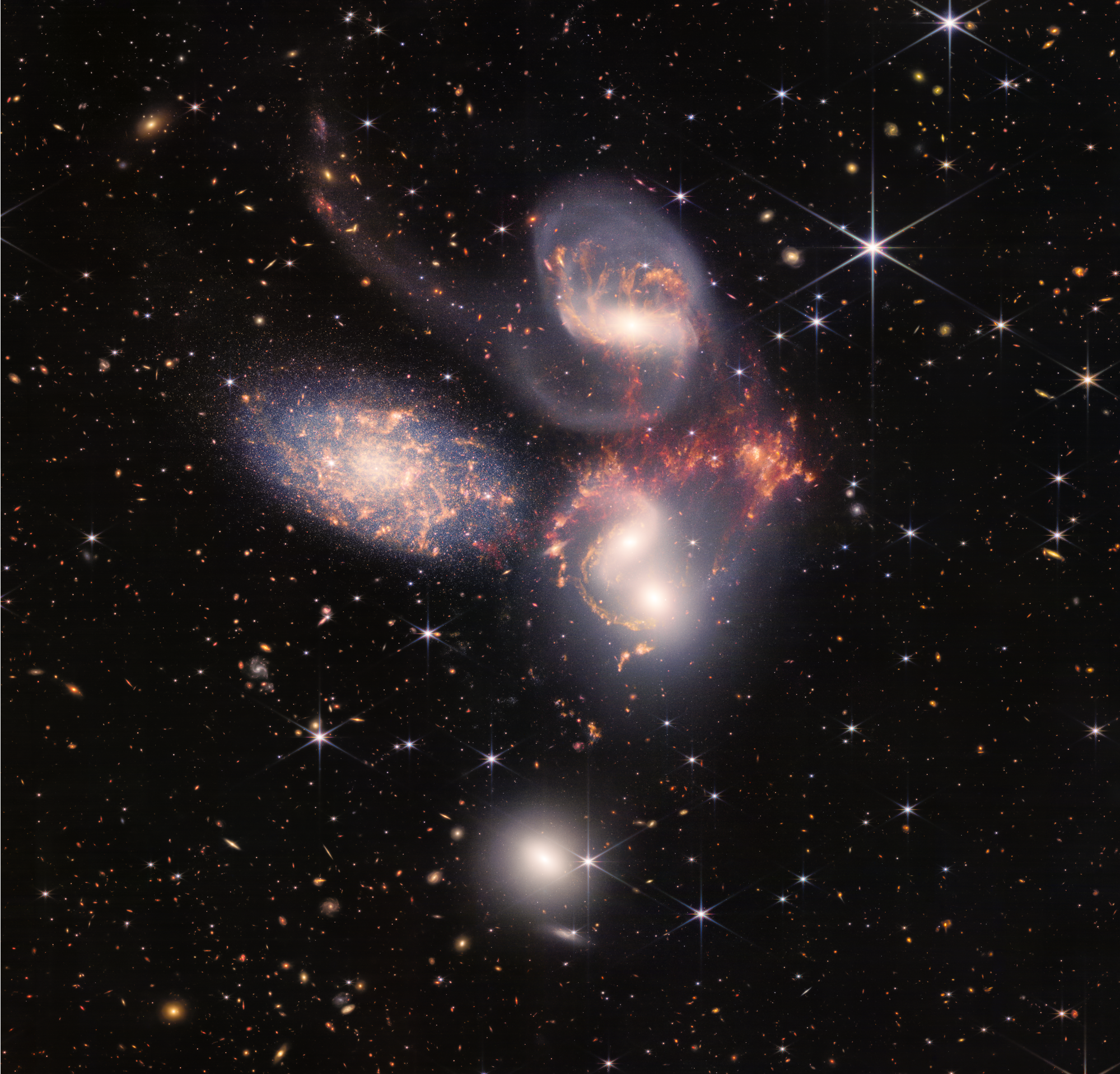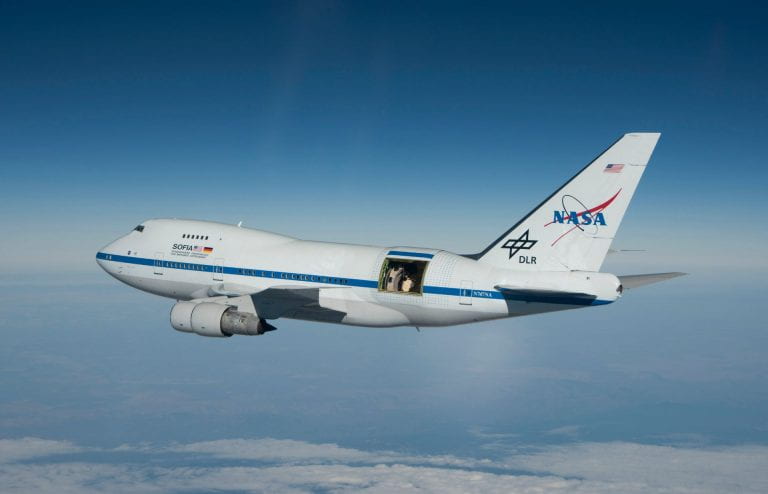ASU Associate Professor Craig Hardgrove is NASA’s Principal Investigator for the Lunar Polar Hydrogen Mapper, or LunaH-Map cubesat.
Tag: NASA

UCI receives $580 million in research funding for fiscal 2021-22
Irvine, Calif., Aug. 25, 2022 — From monitoring sandy beaches to gauge the effects of sea-level rise to holding clinical trials for potentially lifesaving cancer treatments, scholars, scientists and physicians at the University of California, Irvine are blazing new paths to help change the world. And their impact keeps growing.
GW Experts Available to Discuss Russia Leaving the International Space Station
WASHINGTON (July 26, 2022) — Yuri Borisov, head of Russia’s space agency Roscosmos, has announced Russia will withdraw from the International Space Station after 2024 to focus on building a Russian orbiting station. Experts from the George Washington University’s Space…
WVU scientist says NASA’s Webb Telescope will boost space research at University, Green Bank Observatory
The first photos from NASA’s James Webb Space Telescope have given researchers the deepest and clearest infrared look into space to date. West Virginia University researcher Maura McLaughlin, distinguished professor of physics and astronomy at the Eberly College of Arts…

Webb telescope rewrites cosmic history with images of universe
A time travel machine, the $10 billion space observatory is being considered well worth the price tag because it will help answer long-held questions about the big bang and search for signs of alien life, University of Miami astrophysicists maintain.

NASA’s Webb Sheds Light on Galaxy Evolution, Black Holes
In an enormous new image, NASA’s James Webb Space Telescope reveals never-before-seen details of the galaxy group called “Stephan’s Quintet.” The close proximity of this group gives astronomers a ringside seat to galactic mergers and interactions.
UNLV professor available for NASA James Webb Telescope comment
UNLV professor of physics and astronomy Jason Steffen is available to talk about the significance of the James Webb Space Telescope imagery, and how it broadens our understanding of the universe. Today is the day that scientists are saying could…
Specific Environmental Exposures may Help Predict Increased Risk of Death from Cardiovascular Disease
A new study from the Icahn School of Medicine at Mount Sinai quantifies the cardiovascular risk posed by exposure to specific environmental factors, showing, for example, that air pollution heightens the risk of heart disease mortality by 17 percent.
NASA’s Webb to Uncover Riches of the Early Universe
Telescopes have spotted many distant galaxies – but none earlier than 400 million years after the big bang. What were galaxies that existed even earlier like? Two research teams using the James Webb Space Telescope will wield its state-of-the-art instruments to reveal an untold number of details about this early period in the universe for the first time – and revise what we know about some of the earliest chapters of galaxy evolution.

UCI-led astronomy team finds evidence of galactic metal shrouded in dust
A thorough understanding of galaxy evolution depends in part on an accurate measurement of the abundance of metals in the intergalactic medium – the space between stars – but dust can impede observations in optical wavelengths.
On Mars, NASA’s Perseverance Rover’s Playlist Like No Other #ASA182
After more than a year of recording on the surface, the team reduced the data to a Martian playlist that features about five hours of sounds.
Nuclear rocket engine heat transfer research wins best student paper at NETS conference
A research paper about heat transfer inside the reactor of a conceptual liquid-fueled nuclear rocket engine by a University of Alabama in Huntsville (UAH) graduate student won best student paper at the American Nuclear Society’s recent Nuclear and Emerging Technologies for Space (NETS) conference
NASA-Cornell tool to give high-res view of atmospheric dust from space
Scientists on Earth will soon see our planet’s atmospheric dust sources in high-resolution, as a new state-of-the-art imaging spectrometer – developed by NASA’s Jet Propulsion Laboratory (JPL) and Cornell University – aims to survey the land surface from 250 miles above us on the orbiting International Space Station.
Hubble Reaches New Milestone in Mystery of Universe’s Expansion Rate
Completing a nearly 30-year marathon, NASA’s Hubble Space Telescope has calibrated more than 40 “milepost markers” of space and time to help scientists measure the expansion rate of the universe to a precision of just over 1%. The measurement is about eight times more precise than Hubble’s expected capability.
Powering the moon: Sandia researchers design microgrid for future lunar base
Sandia National Laboratories is well-known for designing reliable and resilient microgrids for military bases and vital city services. Now, Sandia researchers are working with NASA to design one for the moon.
UNC Blood Clot Expert Working with NASA to Study Blood Flow, Clot Formation in Zero Gravity
In the ultimate use of telemedicine, Stephan Moll, MD, worked with NASA to treat a U.S. astronaut’s blood clot during a mission on the International Space Station. That led to a study on how blood flows in zero gravity, and if astronauts are at greater risk of developing blood clots in space.
NAU scientist joins extended OSIRIS-REx mission to visit another asteroid
Because of the potential to deepen our understanding of the solar system and beyond, NASA this week extended the missions of eight of its spacecraft, including OSIRIS-REx—and NAU planetary geologist Chris Haberle will be one of the scientists involved in the newly extended project.
NASA funds LLNL to demonstrate “Replicator” 3D printer to produce cartilage in space
The National Aeronautics and Space Administration (NASA) announced April 15 it has awarded Lawrence Livermore National Laboratory (LLNL) and a private company with funding to develop LLNL’s revolutionary volumetric additive manufacturing (VAM) 3D printing technology to produce artificial cartilage tissue in space.
NASA Awards Postdoctoral Fellowships for 2022
NASA has selected 24 new Fellows for its prestigious NASA Hubble Fellowship Program (NHFP). The program enables outstanding postdoctoral scientists to pursue independent research in any area of NASA Astrophysics. Nearly 450 applicants vied for the 2022 fellowships.
Astro2020 prioritizes extraterrestrial life, diversity in astronomy
The newly released Astro2020 decadal survey has ranked the projects the astronomer community wants to prioritize for the next 10 years. The 614-page NASA-sponsored report highlights the search for extraterrestrial life, as well as stressing the need for greater diversity…
Hubble Celebrates Halloween With A Glowering, Dying Star
Hubble celebrates Halloween with a striking view of the aging red giant star CW Leonis. The orange-red cobweb-like shells are dusty clouds of sooty carbon engulfing the dying star. Bright searchlight beams poke through the dust.
Hubble Gives Unprecedented, Early View of a Doomed Star’s Destruction
Hubble delivered a ringside seat to a supernova in the very earliest stage of exploding, giving astronomers an unprecedented view of the first moments of a star’s spectacular death.
Alabama student satellite group shifts gears to ABEX mission to keep up with NASA
The Alabama Space Grant Consortium’s statewide, university student-built cube satellite project is shifting gears to ABEX, the Alabama Burst Energetics eXplorer, after its drive to be the first student-built Cubesat to leave low Earth orbit (LEO) was derailed when NASA dropped secondary payloads from the Artemis II flight.
Hubble Shows Winds in Jupiter’s Great Red Spot Are Speeding Up
The innermost lane may typically be favored to win a race, but in Jupiter’s Great Red Spot, the winds in its outermost “lane” are taking the lead! Only Hubble can spot these trends: The observatory acts like a storm tracker for the giant planets in our solar system every year.
Hubble Snapshot of ‘Molten Ring’ Galaxy Prompts New Research
In this image, a remote galaxy is greatly magnified and distorted by the effects of gravitationally warped space. After its public release, astronomers used the picture to measure the galaxy’s distance of 9.4 billion light-years. This places the galaxy at the peak epoch of star formation in cosmic evolution.
Sanford Burnham Prebys professor Karen Ocorr awarded $2 million from NASA to study flies in space
As part of their larger initiative to understand the effects of space conditions on different organisms, NASA has awarded $2 million to Sanford Burnham Prebys assistant professor Karen Ocorr. The grant will fund a three-year project to study the effects of low gravity on muscle and neuron function in fruit flies and nematode worms aboard the International Space Station.
Hubble Finds Early, Massive Galaxies Running on Empty
Fast and furious—that’s how six massive galaxies in the early universe lived before they literally ran out of gas, shut down star formation, and died. These images are composites from Hubble and ALMA.
SpaceX crew launch signals future of sustainable space exploration
SpaceX is expected to make history tonight with the first all-civilian crew launched into orbit. Mason Peck is a professor of astronautical engineering at Cornell University and previously served as NASA Chief Technologist. Peck says the future of sustainable space exploration is upon…
Rerun of Supernova Blast Is Expected to Appear in 2037
Hubble astronomers are predicting that the fading light from a distant supernova will be rebroadcast in 16 years. This future appearance will be the fourth known view of the same exploded star, dubbed Supernova Requiem.
Hubble Discovers Hydrogen-Burning White Dwarfs Enjoying Slow Aging
Astronomers using Hubble have uncovered burned-out stars that look younger than they really are. After the nuclear furnaces at their cores shut down, the stars continue burning leftover hydrogen on their surface.
What has been discovered about the Mars surface? How does that relate to human missions?
Soil on Mars is different than soil on Earth, and exploration is helping us learn more
Global climate trend since Dec. 1 1978: +0.14 C per decade
Global Temperature Report: August 2021
Countdown to launch: Cornell scientists play key roles in James Webb Space Telescope
NASA’s James Webb Space Telescope — the largest and most powerful space science observatory ever built — is designed to give astronomers unprecedented insight into the mysteries of the cosmos. Webb is an international program led by NASA with its…
Comet ATLAS May Have Been a Blast from the Past
Astronomers who used the Hubble telescope to watch comet ATLAS disintegrate into a cascade of icy fragments in mid-2020, now believe it came from a parent comet that swung by the Sun 5,000 years ago.
Hubble Finds First Evidence of Water Vapor at Jupiter’s Moon Ganymede
Located ½-billion miles from the Sun, the water ice on Ganymede’s surface is frozen solid in frigid temperatures as low as minus 300 degrees Fahrenheit. This makes the ice as hard as rock. Still, a rain of charged particles from the Sun is enough to turn the ice into water vapor at high noon on Ganymede. This is the first time such evidence has been found, courtesy of the Hubble Space Telescope’s spectroscopic observations of aurora on Ganymede spanning two decades. The auroras are used to trace the presence of oxygen, which then is linked to the presence of water molecules sputtering off the surface. Ganymede has a deep ocean located an estimated 100 miles below the surface.
$1M NASA grant to improve carbon monitoring in East Africa
Cornell University researchers will develop the first high-resolution carbon monitoring system for East Africa that combines “bottom up” ecological modeling with “top down” satellite data, thanks to a three-year, $1 million NASA grant.
First Images from Rebooted Hubble: Astronomers Peer at Oddball Galaxies
These early snapshots demonstrate Hubble’s return to full science operations, following correction of a computer anomaly aboard the spacecraft. Normal science observations were restarted on July 17, at 1:18 pm EDT.
Global climate trend since Dec. 1 1978: +0.14 C per decade
Global Temperature Report: June 2021
(New Reference Base, 1991-2020)
Space Race with China: expert talk & interview availability
A New Space Race? Rediscovering Star Wars and the new High Frontier Tuesday, July 13 at 4PM EDT. The Foreign Press Association is hosting a critical talk by space policy and business expert Professor Greg Autry on China’s advances in…
When the James Webb telescope launches, 25 years of UAH R&D involvement will soar
After a scheduled November launch, when NASA’s James Webb Space Telescope (JWST) achieves orbit and unfurls the 18 gold-coated beryllium segments of its 6.5-meter primary mirror, over two decades of crucial UAH partnership in the project will also blossom.
FAU Lands $736,000 from NASA to Study the Coastal Carbon Budget from Space
If successful, this research in the Gulf of Mexico’s hypoxia region off the coasts of Texas and Louisiana may demonstrate not just the ability, but also the utility, of remote sensing as an observational technique for characterizing potentially critical but often neglected carbon cycle processes related to marine sediments. Researchers will use satellite images, hydrodynamic modeling and field work in seeking a better understanding of the ocean’s role in the Earth system.

Climate change is driving plant die-offs in Southern California, UCI study finds
Irvine, Calif., June 21, 2021 – A shift is happening in Southern California, and this time it has nothing to do with earthquakes. According to a new study by scientists at the University of California, Irvine, climate change is altering the number of plants populating the region’s deserts and mountains. Using data from the Landsat satellite mission and focusing on an area of nearly 5,000 square miles surrounding Anza-Borrego Desert State Park, the research team found that between 1984 and 2017, vegetation cover in desert ecosystems decreased overall by about 35 percent, with mountains seeing a 13 percent vegetation decline.
Saint Louis University Student Searches for Possible Origins of Life on Saturn’s Largest Moon
Chemistry grad student Steven Skaggs was recently selected for funding by the Future Investigators in NASA Earth and Space Science and Technology (FINESST) program.
Mystery of Galaxy’s Missing Dark Matter Deepens
Hubble astronomers say they confirmed that an oddball
galaxy mysteriously lacks dark matter—the glue that holds stars and gas together in galaxies. This confirmation challenges the standard ideas of how researchers think galaxies work.
NASA Awards The University of Texas at El Paso $2 Million Grant
The University of Texas at El Paso has earned a $2 million grant from NASA to develop technologies to mine ice on the moon for future deep space exploration.
Global climate trend since Dec. 1 1978: +0.14 C per decade
Global Temperature Report: May 2021
(New Reference Base, 1991-2020)
Venus Expert Available to Comment on New NASA Missions to Explore Planet Habitability
Clara Sousa-Silva is a quantum astrochemist at the Center for Astrophysics | Harvard & Smithsonian who has studied the potential for life on Venus. In 2020, she helped detect phosphine in the planet’s atmosphere, suggesting that life may exist in…
Lopsided Galaxy NGC 2776
The magnificent spiral galaxy NGC 2276 looks a bit lopsided in this Hubble Space Telescope snapshot. A bright hub of older yellowish stars normally lies directly in the center of most spiral galaxies. But the bulge in NGC 2276 looks offset to the upper left.
Urban heat islands affect tree canopy temperatures and health, UAH study says
New research recently published in Scientific Reports on tree canopy temperatures in New York City by a University of Alabama in Huntsville (UAH) doctoral student offers new insights for urban forestry management.
36 Dwarf Galaxies Had Simultaneous “Baby Boom” of New Stars
Three dozen dwarf galaxies far from each other had a simultaneous “baby boom” of new stars, an unexpected discovery that challenges current theories on how galaxies grow and may enhance our understanding of the universe. Galaxies more than 1 million light-years apart should have completely independent lives in terms of when they give birth to new stars. But galaxies separated by up to 13 million light-years slowed down and then simultaneously accelerated their birth rate of stars, according to a Rutgers-led study published in the Astrophysical Journal.